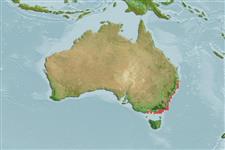>
Ovalentaria/misc (Various families in series Ovalentaria) >
Pomacentridae (Damselfishes) > Microspathodontinae
Etymology: Parma: Latin, parma, -ae = a little shield.
More on author: Günther.
Environment: milieu / climate zone / profondeur / distribution range
Écologie
marin récifal; non migrateur; profondeur 2 - 30 m (Ref. 7247). Temperate; 29°S - 39°S, 144°E - 154°E
Southwest Pacific: southern Australia between Byron Bay, New South Wales and Port Phillip Bay, Victoria.
Taille / Poids / Âge
Maturité: Lm ? range ? - ? cm
Max length : 14.0 cm SL mâle / non sexé; (Ref. 7247); âge max. reporté: 37 années (Ref. 52465)
Description synthétique
Clés d'identification | Morphologie | Morphométrie
Épines dorsales (Total) : 13; Rayons mous dorsaux (Total) : 16 - 18; Épines anales: 2; Rayons mous anaux: 14 - 16.
Body shape (shape guide): short and / or deep; Cross section: compressed.
Adults inhabit rocky reefs (Ref. 7247). Oviparous, distinct pairing during breeding (Ref. 205). Eggs are demersal and adhere to the substrate (Ref. 205). Males guard and aerate the eggs (Ref. 205).
Life cycle and mating behavior
Maturité | Reproduction | Frai | Œufs | Fécondité | Larves
Oviparous, distinct pairing during breeding (Ref. 205). Eggs are demersal and adhere to the substrate (Ref. 205). Males guard and aerate the eggs (Ref. 205). Also Ref. 103751.
Allen, G.R., 1991. Damselfishes of the world. Mergus Publishers, Melle, Germany. 271 p. (Ref. 7247)
Statut dans la liste rouge de l'IUCN (Ref. 130435: Version 2025-1)
Menace pour l'homme
Harmless
Utilisations par l'homme
Outils
Articles particuliers
Télécharger en XML
Sources Internet
Estimates based on models
Preferred temperature (Réf.
123201): 15.3 - 23.2, mean 18.2 °C (based on 45 cells).
Phylogenetic diversity index (Réf.
82804): PD
50 = 0.5010 [Uniqueness, from 0.5 = low to 2.0 = high].
Bayesian length-weight: a=0.01995 (0.00910 - 0.04376), b=2.99 (2.80 - 3.18), in cm total length, based on LWR estimates for this (Sub)family-body shape (Ref.
93245).
Niveau trophique (Réf.
69278): 2.7 ±0.24 se; based on food items.
Generation time: 3.2 ( na - na) years. Estimated as median ln(3)/K based on 2
growth studies.
Résilience (Réf.
120179): Faible, temps minimum de doublement de population : 4,5 à 14 années (K=0.34-0.37; tmax=37).
Fishing Vulnerability (Ref.
59153): Low to moderate vulnerability (30 of 100).
🛈
Nutrients (Ref.
124155): Calcium = 29.1 [12.0, 53.4] mg/100g; Iron = 0.232 [0.130, 0.440] mg/100g; Protein = 18.4 [17.2, 19.7] %; Omega3 = 0.282 [0.143, 0.577] g/100g; Selenium = 5.32 [2.30, 12.88] μg/100g; VitaminA = 62.5 [13.0, 300.1] μg/100g; Zinc = 0.815 [0.494, 1.364] mg/100g (wet weight);
